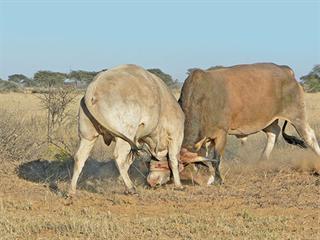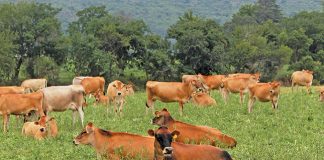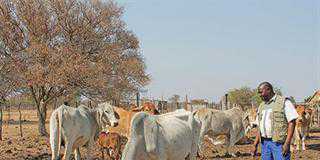
Sexually transmitted diseases (STDs) in cattle are on the rise in South Africa. The latest monthly report from the South African Veterinary Association shows that the venereal diseases trichomoniasis and vibriosis are re-emerging in beef herds. In June and July, participating vets reported 17 outbreaks of trichomoniasis and nine of vibriosis in the central and northern parts of the country.
Dr Dietmar Holm of the Department of Veterinary Science at the University of Pretoria explains that factors promoting the re-emergence of STDs include poor biosecurity (specifically ineffective fencing and breeders selling or loaning untested bulls), the ignorance of farmers in mixed operations where beef cattle are not central, and laymen illegally offering veterinary services to farmers.
The Red Meat Producers’ Organisation (RPO) is also concerned about the increased incidence of reported diseases.
James Faber, chairperson of the Northern Cape Red Meat Producers’ Organisation (NCRPO), warns that if disease control is not tightened up soon, the country might face a crisis. It is quite possible for one infected bull to cost a commercial cattleman thousands of rands worth of damage.
Economic impact
A team of veterinarians under the guidance of Holm recently conducted a study to quantify the financial impact of trichomoniasis on a commercial beef herd. A small commercial herd that experienced a decrease in its calving rate in 2010 was used as basis for the research. “This operation runs multi-sire breeding groups year-round. Bulls and cows, many without veterinary certificates for breeding soundness, were bought in previous years,” explains Holm.
“The owner, having relatively little experience, had confused pedigree certificates with veterinary breeding soundness certificates.” In 2010, when the bulls were tested, four out of five were positive for trichomoniasis. One of the older (trich-positive) bulls was sold, while the bulls that tested negative for trich were separated and run in the ‘clean’ herd. Cows were moved within a week of calving, while the trich-positive bulls were kept in the ‘infected’ herd.
In 2011, 84 cows were tested for pregnancy and only 35 were confirmed in-calf. “About 4% of the open cows had aborted during the preceding months,” says Holm. Researchers later established that trichomoniasis had probably been introduced to the herd in 2009 when the herd’s calving rate plummeted, with an equivalent increase in the inter-calving period (ICP).
Holm says that because the herd was not managed on the principles of seasonal breeding, calculating the financial impact of the infection on the herd was difficult. “We estimated from the herd data that about 10 fewer calves per year were born from 2009 to 2011 than was the case in previous years. This means a direct loss of R37 800 per year at an average weaner price of R18/ kg and average weight of 210kg.”
The team established that the farmer had also suffered a loss in replacement heifers born. “Due to the strategy of replacing cows from the herd, it would be difficult to maintain the herd size in the following few years with the small calf crop from 2009 to 2011,” Holm continues. “This would force the farmer to keep less productive cows for longer or to buy in replacement stock.”
He says that the cost would be difficult to calculate, but one could estimate that about five fewer heifer calves were born annually from 2009 to 2011, forcing the farmer to buy five heifers a year. “If the market value of a heifer is R6 000, this amounts to an additional cost of R30 000 per year.” There are also indirect costs, such as the expense of delayed calving that leads to delayed marketing.
“In previous years, the farmer was able to market a calf crop from May to July. However, in 2010, 2011 and 2012, he could market most of them only in November,” says Holm. As the herd forms part of a farmer’s capital investment, there is real interest lost when the asset fails to perform productively. Other economic losses caused by this disease include veterinary costs and higher management costs during and after calving.
It was estimated that the cost of labour directly linked to disease management could have increased by R2 500 per year over the two-year period. As the herd could not be certified free of trichomoniasis, further marketing losses would be incurred. “Although these are difficult to quantify, marketing heifers and cows profitably from an infected herd will be difficult in the long term. The combined costs boil down to a financial loss of R150 000 in this herd over a two-year period,” says Holm.
Testing
Despite the financial risk cattlemen face due to venereal diseases, it seems that very few are regulating their bulls.
At the recent NCRPO congress, only 12% of the 108 delegates had used the organisation’s subsidy scheme for bull testing. “The subsidy is aimed at testing bulls and rams for fertility and disease to increase the province’s reproduction,” says Faber.
“Any farmer paying his or her RPO voluntary levy qualifies for the subsidy, which has been available for five years. Over the past year, R48 580 was paid out to test 2 429 rams, while only 146 bulls were tested in terms of the scheme at a cost of R14 600. “It’s not to say that this is a true reflection of the amount of testing that takes place in the province, because farmers might be conducting private tests.”
He said it was alarming that more farmers were not making use of this scheme. “Until recently, the RPO’s subsidy to test a bull was R300 while the Veterinary Services State Veterinarian charged R100 per test. The latter figure has recently increased to R300/bull, which means a farmer still need not pay for this service.”
Poor fences – poor Biosecurity
A major issue affecting the transmission of venereal diseases is biosecurity, a bull jumping the fence being a major concern. Holm therefore recommends that bulls be tested before every breeding season. “Positive bulls must be culled and replaced with virgin bulls or with those certified negative,” he says. A shorter breeding season and pregnancy diagnosis two months after the end of the breeding season will detect problems sooner, says Holm, who discourages farmers from buying open cows or heifers that may have been exposed to a bull.
“The spread of the disease from the neighbouring herd can be prevented by maintaining a sound fence,” he adds. Faber agrees: “We’re worried about bulls on communal land, where cattle are not regularly tested and could infect neighbouring herds.” Farmer’s Weekly asked the NC DAFF about government measures to curb the spread of STDs but at the time of going to press, no answer had been received.
Disease guide
Bovine venereal trichomoniasis, a venereal disease of cattle, is caused by the flagellate protozoan parasite Tritrichomonas foetus. The parasite can survive in the male and female reproductive tracts for a variable time period. In a bull, there are typically no clinical symptoms and the protozoa does not affect the semen. However transmission to cows, particularly heifers, leads to the death of the foetus through resorption or abortion.
A hallmark sign of the presence of trich is a sudden and significant drop in pregnancy or calving rates. In a chronically infected herd, it is an erosive disease increasing the age of first calving in heifers and lengthening the intercalving period. The widespread use of artificial insemination in cattle has greatly reduced its impact.
Vibriosis is a similar disease to trichomoniasis, but it is caused by the bacterium Campylobacter foetus subs venerealis. It produces similar effects. The most important difference is that vibriosis is easier to control, with effective vaccines available. The economic impact of uncontrolled vibriosis will be the same as that of trichomoniasis.
Email Dr Dietmar Holm at [email protected] or visit www.lhpg.co.za. Phone the NCRPO on 053 832 9595.













